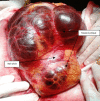[Retroperitoneal cystic lymphangioma: about 5 cases and review of the literature]
- PMID: 28292036
- PMCID: PMC5324145
- DOI: 10.11604/pamj.2016.25.73.10002
[Retroperitoneal cystic lymphangioma: about 5 cases and review of the literature]
Abstract
Cystic lymphangioma is a rare, benign malformation of the lymphatic vessels which may be observed on various locations. Retroperitoneal location is less common than mesenteric location. Cystic lymphangioma has a polymorphic clinical presentation. Diagnosis is based on imaging but requires histological confirmation. Surgery is the treatment of choice. The aim of our study is to analyze the clinical manifestations, complications, diagnostic and therapeutic aspects of this tumor. We report a case series of 5 patients with retroperitoneal cystic lymphangioma (4 women and 1 man) operated in our department between the years 2004 and 2014. Their medical records were reviewed retrospectively. Follow-up was based on clinical examination and abdominal CT scan. The average age was 45 years. The mean follow-up was 32.6 months. The most common symptoms indicative of retroperitoneal cystic lymphangioma were pains and/or an abdominal mass. Abdominal CT scan was the most useful diagnostic test. Total resection was immediately achieved in 4 patients and it was deferred for up to 5 years in one patient. He underwent annual ultrasound monitoring. One patient underwent nephrectomy. No recurrence or complications were noted in 5 patients. Retroperitoneal cystic lymphangioma is a rare condition. Its therapeutic management is based on complete resection in patients with symptomatic lesions or complications, in order to limit the risk of recurrence. Complete resection may be deferred in asymptomatic patients.
Le lymphangiome kystique est une tumeur bénigne malformative rare des vaisseaux lymphatiques à localisations diverses. La localisation rétropéritonéale est moins fréquente comparée à celle mésentérique. Sa présentation clinique est polymorphe. Le diagnostic est évoqué par l'imagerie mais il nécessite une confirmation histologique. Le traitement de choix est chirurgical. Notre objectif est d'étudier les manifestations cliniques, les complications, les aspects diagnostiques et thérapeutiques de cette tumeur. Nous rapportons une série de 5 cas de lymphangiomes kystiques rétropéritonéaux (4 femmes et un homme) opérés dans notre service entre les années 2004 et 2014. Leurs dossiers ont été examinés rétrospectivement. Le suivi était basé sur l'examen clinique et l'échographie abdominale. L´âge moyen était de 45 ans. Le suivi moyen était de 32,6 mois. La symptomatologie révélatrice la plus fréquente était les douleurs et/ou une masse abdominale. Le scanner abdominal était l'examen le plus utile au diagnostic. Une exérèse complète était réalisée d'emblée chez quatre patients et elle était différée après cinq ans de surveillance par une échographie annuelle chez un. Dans un cas, on a eu recours à une néphrectomie. Aucune récidive ni complication n´ont été notées chez les 5 patients. le lymphangiome kystique à localisation rétropéritonéale est une affection rare. Sa prise en charge thérapeutique repose sur une exérèse complète, de cas de lésions symptomatiques ou de complications, pour limiter le risque de récidive. Cette dernière peut être différée chez les patients asymptomatiques.
Keywords: Retroperitoneal cystic lymphangioma; diagnosis; surgery; treatment.
Conflict of interest statement
Les auteurs déclarent ne pas avoir de conflits d'intérêts en relation avec cet article.
Figures




Similar articles
-
Adult presentation of giant retroperitoneal cystic lymphangioma: case report.Int J Surg. 2009 Dec;7(6):559-60. doi: 10.1016/j.ijsu.2009.09.005. Epub 2009 Oct 6. Int J Surg. 2009. PMID: 19815102
-
[CASE REPORT: COMPLETE RESECTION OF RETROPERITONEAL CYSTIC LYMPHANGIOMA AND SURROUNDING ORGANS].Nihon Hinyokika Gakkai Zasshi. 2019;110(1):52-55. doi: 10.5980/jpnjurol.110.52. Nihon Hinyokika Gakkai Zasshi. 2019. PMID: 31956220 Japanese.
-
Mesenteric calcified cystic lymphangioma in an adult patient.Turk J Gastroenterol. 2011 Jun;22(3):341-3. doi: 10.4318/tjg.2011.0224. Turk J Gastroenterol. 2011. PMID: 21805428
-
[Retroperitoneal cystic lymphangiomas in adults: four case reports and review of the literature].J Med Liban. 2008 Jan-Mar;56(1):42-5. J Med Liban. 2008. PMID: 19534090 Review. French.
-
Retroperitoneal cystic lymphangioma.J Surg Oncol. 1996 Mar;61(3):234-7. doi: 10.1002/(SICI)1096-9098(199603)61:3<234::AID-JSO14>3.0.CO;2-7. J Surg Oncol. 1996. PMID: 8637214 Review.
Cited by
-
Giant retroperitoneal lymphangioma in a 70-year-old male: a case report.Pan Afr Med J. 2022 Jun 24;42:153. doi: 10.11604/pamj.2022.42.153.34175. eCollection 2022. Pan Afr Med J. 2022. PMID: 36187030 Free PMC article.
-
Characteristics of adult retroperitoneal lymphangioma: a single center Chinese cohort study of 15 cases.Discov Oncol. 2024 Jul 4;15(1):262. doi: 10.1007/s12672-024-01143-5. Discov Oncol. 2024. PMID: 38963421 Free PMC article.
-
Case report and literature review: Giant retroperitoneal cystic lymphangioma.Front Surg. 2023 Jan 17;10:1074067. doi: 10.3389/fsurg.2023.1074067. eCollection 2023. Front Surg. 2023. PMID: 36733888 Free PMC article.
-
Retroperitoneal cystic lymphangioma in an adult: A case report.Urol Case Rep. 2018 Mar 1;18:33-34. doi: 10.1016/j.eucr.2018.02.019. eCollection 2018 May. Urol Case Rep. 2018. PMID: 29785367 Free PMC article. No abstract available.
-
[Cystic hygroma of the neck in a young adult: about a case and literature review].Pan Afr Med J. 2020 Jun 2;36:54. doi: 10.11604/pamj.2020.36.54.21758. eCollection 2020. Pan Afr Med J. 2020. PMID: 32774629 Free PMC article. Review. French.
References
-
- Zekri B, Mouaqit O, Affari O, Ifrine L, El Malki HO, Mohsine R, Belkouchi A. Lymphangiome kystique rétropéritonéal. J Afr Hépatol Gastroentérol. 2010;4:260–262.
-
- Losanoff JE, Richman BW, El-Sherif A. Mesenteric cystic lymphogioma. J Am Coll Surg. 2003;196(4):598–603. - PubMed
-
- Rifki Jai S, Adraoui J, Khaiz D, Chehad F, Lakhloufi A, Bouzidi A. Le lymphangiome kystique rétropéritonéal. Prog Urol. 2004;14(4):548–550. - PubMed
-
- Bezzola T, Bühler L, Chardot C, Morel P. Le traitement chirurgical du lymphangiome kystique abdominal chez l'adulte et chez l'enfant. J Chir (Paris). 2008;145(3):238–243. - PubMed
-
- Zoguéreh DD, N'Tarundenga U, Provendier B, Gazaigne J. Une volumineuse masse rétropéritonéale chez un adulte. Rev Med Interne. 2003;24(3):202–203. - PubMed
Publication types
MeSH terms
Supplementary concepts
LinkOut - more resources
Full Text Sources
Other Literature Sources
Medical
